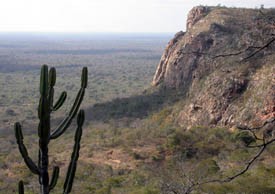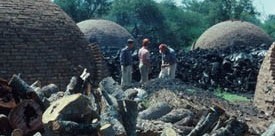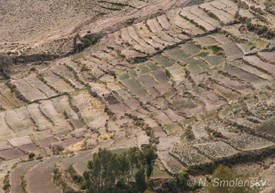 The Gran Chaco, in Paraguay, Bolivia, and Argentina, is a tropical dry forest and the third largest biome in South America. Rates of deforestation of the Gran Chaco equal or exceed global trends – 85% of original lowland and montane Chaco forests were cleared over the last 30 years (Zak et al. 2004). The abundant biodiversity of the Gran Chaco has been under-appreciated by the conservation community, perhaps because species numbers are higher in Amazonia, and media focus is on rainforests. In fact, Neotropical drylands support more endemic mammals than does Amazonia (Mares 1986) and species richness of mammals >1kg in the Chaco is almost as high as in the most speciose Amazonian sites (Redford et al. 1990).
The Gran Chaco, in Paraguay, Bolivia, and Argentina, is a tropical dry forest and the third largest biome in South America. Rates of deforestation of the Gran Chaco equal or exceed global trends – 85% of original lowland and montane Chaco forests were cleared over the last 30 years (Zak et al. 2004). The abundant biodiversity of the Gran Chaco has been under-appreciated by the conservation community, perhaps because species numbers are higher in Amazonia, and media focus is on rainforests. In fact, Neotropical drylands support more endemic mammals than does Amazonia (Mares 1986) and species richness of mammals >1kg in the Chaco is almost as high as in the most speciose Amazonian sites (Redford et al. 1990).
 Land use varies among the three countries, creating a panorama for studying and understanding impacts on the Chaco in relation to different economies, development histories, and national policies. Deforestation for ranching, agriculture, and fuel led to conversion of much of the Argentine Chaco by the mid-20th century, primarily because of demand for beef for European markets, and demand for railroad ties and fuel for the Argentine railroad system (Schofield and Bucher 1986; Grau and Brown 2000). What remains of the Argentine Chaco is largely a fragmented mosaic of land uses.
Land use varies among the three countries, creating a panorama for studying and understanding impacts on the Chaco in relation to different economies, development histories, and national policies. Deforestation for ranching, agriculture, and fuel led to conversion of much of the Argentine Chaco by the mid-20th century, primarily because of demand for beef for European markets, and demand for railroad ties and fuel for the Argentine railroad system (Schofield and Bucher 1986; Grau and Brown 2000). What remains of the Argentine Chaco is largely a fragmented mosaic of land uses.
 Ranching and unsustainable agriculture are also problematic for the Chaco forests in Paraguay. The Paraguayan Chaco remained largely unsettled until the 1980s, with the exception of the Mennonite colony of Filadelfia established in the 1920s. The rapid expansion of Filadelfia and neighboring Mennonite colonies in the 1980s led to deforestation, rapid salinization and desertification. Mennonite leaders are now implementing sustainable land use practices. Forest clearing in Paraguay is also associated with the Trans-Chaco Highway. A critical conservation locus for the Paraguayan Chaco is the Parque Nacional Defensores del Chaco near the Bolivian border. Efforts have been initiated to link this park with adjacent conservation areas in the Bolivian Chaco.
Ranching and unsustainable agriculture are also problematic for the Chaco forests in Paraguay. The Paraguayan Chaco remained largely unsettled until the 1980s, with the exception of the Mennonite colony of Filadelfia established in the 1920s. The rapid expansion of Filadelfia and neighboring Mennonite colonies in the 1980s led to deforestation, rapid salinization and desertification. Mennonite leaders are now implementing sustainable land use practices. Forest clearing in Paraguay is also associated with the Trans-Chaco Highway. A critical conservation locus for the Paraguayan Chaco is the Parque Nacional Defensores del Chaco near the Bolivian border. Efforts have been initiated to link this park with adjacent conservation areas in the Bolivian Chaco.
Parts of the Bolivian Chaco remain relatively isolated and undeveloped, but extensive areas have been deforested for export-led soybean cultivation, and by Mennonite colonies and Bolivian and expatriate ranchers. The result is environmentally unsustainable modern agriculture alongside economically unsustainable traditional resource-use systems. Rapid changes are resulting from the Bolivia-Brazil gas pipeline (Pató 2000) and associated rail and road links. The Chaco in Bolivia is especially notable among conservationists for having one of the world’s largest protected areas co-managed by indigenous people. The 3.4 million hectare Kaa-Iya del Gran Chaco National Park, on the Bolivia-Paraguay border, is administered by the Capitanía de Alto y Bajo Izozog representing some 9,500 Guarani Izoceños in 25 communities. The Izoceños own >300,000 ha of adjacent territorial lands, which they use for hunting and resource extraction (Arambiza and Painter 2006).
Literature Cited:
Arambiza E. and M. Painter. 2006. Biodiversity conservation and the quality of life of indigenous people in the Bolivian Chaco. Human Organization 65:20-34.
Grau A., Brown A.D. 2000. Development threats to biodiversity and opportunities for conservation in the mountain ranges of the upper Bermejo River Basin, NW Argentina and SW Bolivia. Ambio 29:445-450.
Mares M.A. 1986. Neotropical mammals and the myth of Amazonian Biodiversity. Science 255:976-979.
Pató, Z. (2000) Piping the Forest: The Bolivia-Brasil Gas Pipeline, CEE Bankwatch Network Case Study, January, available at http://www.bankwatch.org.
Redford K.H., A. Taber, J.A. Simonetti. 1990. There is more to biodiversity than the tropical rainforests. Conservation Biology 4:328-330.
Schofield C.J., E.H. Bucher. 1986. Industrial contributions to desertification in South America. Trends in Ecology and Evolution 1: 78-80.
Zak M.R, M. Cabido, J.G. Hodgson. 2004. Do subtropical seasonal forests in the Gran Chaco, Argentina, have a future? Biological Conservation 120:589-598.

